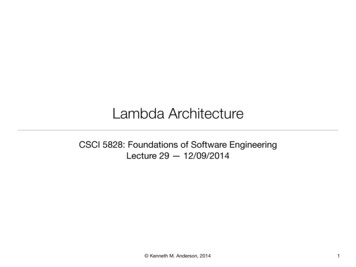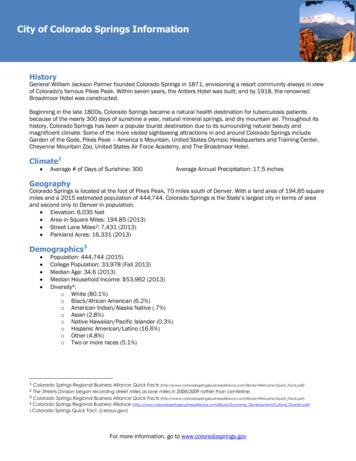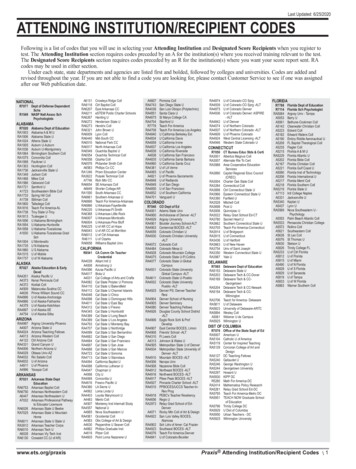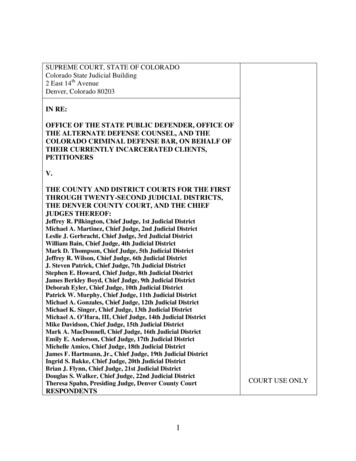
Transcription
Lambda ArchitectureCSCI 5828: Foundations of Software EngineeringLecture 29 — 12/09/2014 Kenneth M. Anderson, 20141
Goals Cover the material in Chapter 8 of the Concurrency Textbook The Lambda Architecture Batch Layer MapReduce (e.g. Hadoop, Spark) Speed Layer Stream Processing (e.g. Storm, Spark Streaming) Kenneth M. Anderson, 20142
Lambda Architecture (I) The Lambda Architecture refers to an approach for performing “big data”processing developed by Nathan Marz from his experiences at BackType and Twitter Everyone has their own definition of “big” gigabytes and terabytes for small research teams and companies terabytes and petabytes for medium and large organizations Google and Microsoft have petabytes of map data exabytes for truly data-intensive organizations Facebook reports having to store 500 TB of new information PER DAY and zettabytes and yottabytes may be in our future some day! Kenneth M. Anderson, 20143
Lambda Architecture (II) Everything changes when working at scale many of your assumptions fall over many of the techniques that you are comfortable suddenly reveal that theyare not scalable I enjoy giving students their first 60 GB file to work on In my research on Project EPIC, we have data sets that are hundreds ofgigabytes in size you can’t bring the entire set into memory (at least not on a singlemachine) you can’t easily store our data sets accumulated over the past five yearson a single machine Kenneth M. Anderson, 20144
Lambda Architecture (III) In a typical data-intensive system, the goal is to while true collect and/or generate raw data store that data in an effective and efficient way process it to answer questions of some form use the answers to determine what new questions you have use those questions to determine what new data you need In our coverage of the Lambda Architecture, we will be looking primarily attechnologies that aid the “process” stage above Additional details can be found in Marz’s book on Big Data Kenneth M. Anderson, 20145
Lambda Architecture (IV) In processing data to answer questions, the lambda architecture advocates atwo-prong approach For large data sets, where the processing can take a significant amount oftime (hours) the batch layer using techniques like MapReduce For more recent generated data, process it as it arrives the speed layerusing techniques like stream processing In both cases, these technologies will make use of clusters of machinesworking together to perform the analysis in this way data is distributed/replicated across machines AND computation is distributed across machines and occurs in parallel Kenneth M. Anderson, 20146
Lambda Architecture (V)JobRawDataJobJobJobJobBatch LayerJobAnswersandInformationSpeed Layer Kenneth M. Anderson, 20147
Lambda Architecture (VI) For the batch layer, we will make use of techniques that can process largesets of data using “batch jobs” MapReduce, as implemented by Hadoop, has been the 900lb gorilla in thisspace for a long time it is now being challenged by other implementations (such as Spark) For the speed layer, we will make use of techniques that can processstreaming data quickly The exemplar in this space is Storm, a streaming technology developed atTwitter Other techniques useful in this space include message queueingsystems like RabbitMQ and ActiveMQ Kenneth M. Anderson, 20148
Map Reduce The functions map, reduce, and filter have cropped up a lot this semester They represent a fundamental approach to processing data that (viaHadoop) has been shown to apply to extremely large data sets map: given an array and a function, create a new array that for each element contains the results of the function applied to the corresponding element of the original array filter: given an array and a boolean function, create a new array that consists of all elements of the original for which the function returns true reduce: given an array, an initial value, and a binary function return a single value that is the accumulation of the initial value and theelements of the original array as computed by the function Kenneth M. Anderson, 20149
Examples: map, filter, and reduce In the subsequent examples, I present examples of map, filter, and reducethat apply to arrays of integers With map, the supplied function has signature: Int - Int With filter, the supplied function has signature: Int - Bool With reduce, the supplied function has signature: (Int, Int) - Int But the technique is generic with respect to type For an array of elements of type T the supplied function for map has signature: T - U the supplied function for filter has signature: T - Bool the supplied function for reduce has signature: (R, T) - R Kenneth M. Anderson, 201410
Example: map (I)function map(values, f) {var results [];for (var i 0; i values.length; i ) {results.push(f(values[i]));}return results;} Here’s a Javascript implementation of map Create a new array Apply the function f to each element of the input array (values) and append (push in Javascript) the result to the output array Kenneth M. Anderson, 201411
Example: map (II)function triple(x) {return x * 3;}var data [0, 1, 2, 3, 4, 5, 6, 7, 8, 9]console.log(map(data, triple)) Here’s an example of using our Javascript version of map Define a function that takes an integer and produces an integer Create an array of integers Call map passing the input array and function; print the result Kenneth M. Anderson, 201412
Example: filter (I)function filter(values, f) {var results [];for (var i 0; i values.length; i ) {if (f(values[i])) {results.push(values[i]);}}return results;} Here’s a Javascript implementation of filter Create a new array Apply the function f to each element of the input array (values) If true, append the element to the output array Kenneth M. Anderson, 201413
Example: filter (II)function isEven(x) {return (x % 2) 0;}var data [0, 1, 2, 3, 4, 5, 6, 7, 8, 9]console.log(filter(data, isEven)) Here’s an example of using our Javascript version of filter Define a function that takes an integer and produces a boolean Create an array of integers Call filter passing the input array and function; print the result Kenneth M. Anderson, 201414
Example: reduce (I)function reduce(values, initial, f) {var result initial;for (var i 0; i values.length; i ) {result f(result, values[i]);}return result;} Here’s a Javascript implementation of reduce Set result equal to the initial value Loop through the input array Update result to be the output of the function applied to result and a[i] Return the final result Kenneth M. Anderson, 201415
Example: reduce (II)function sum(total, value) {return total value;}var data [0, 1, 2, 3, 4, 5, 6, 7, 8, 9]console.log(reduce(data, 0, sum)) You can even combine them! console.log(reduce(filter(map(data, triple), isEven), 0, sum)) Kenneth M. Anderson, 201416
Reduce is very powerful In some languages, you can implement map and filter using reduce func rmap T, U (xs: [T], f: T - U) - [U] { return reduce(xs, []) { result, x in result [f(x)] } } func rfilter T (xs: [T], check: T - Bool) - [T] { return reduce(xs, []) { result, x in return check(x) ? result [x] : result } } This is an example written in Swift, a new language created by Apple Kenneth M. Anderson, 201417
MapReduce and Hadoop (I) Hadoop applies these functions to data at large scale You can have thousands of machines in your cluster You can have petabytes of data The Hadoop file system will replicate your data across the nodes The Hadoop run-time will take your set of map and reduce jobs anddistribute across the cluster It will manage the final reduce process and ensure that all results endup in the output file that you specify It does all of this and will complete jobs even if worker nodes go downtaking out partially completed tasks Kenneth M. Anderson, 201418
MapReduce and Hadoop (II) Since I showed that map and filter are special cases of reduce, theoverarching framework could have been called ReduceReduce but that doesn’t sound as good But that’s just to say that you should be confident that the MapReduceframework provides you with a sufficient range of functionality to perform awide range of analysis and data manipulation tasks Kenneth M. Anderson, 201419
MapReduce and Hadoop (III) Hadoop’s basic mode of operation is transformation A function (either map or reduce) will receive a document of key-valuepairs The result is a set of new documents with key-value pairs In all cases, you are transforming from one set of documents to another Or more generically, one type to another type Depending on your algorithm, one input document can produce multipleoutput documents Kenneth M. Anderson, 201420
MapReduce and Hadoop (IV) The difference between map and reduce in Hadoop map functions will receive a single document to transform As I indicated, it will then produce zero or more output documents each with a particular key; the key does not have to be unique reduce functions will receive a key and a set of documents that all had that key It will then typically produce a single document with that key in which all of the documents have had their values combined insome way So, if a map phase generates millions of documents across 26 different keys then its reduce phase may end producing 26 final documents Kenneth M. Anderson, 201421
Hadoop Conceptual StructureDay 1: MapReduceinput 227outputImage from ourconcurrency text adoop guarantees that allFigure 19—Hadoop high-level data flow This is called the shufflemapper outputs associatedphase, while it routesShuffle Phasesize would be 64 MB) and sends each split to a single mapper. The mapperwith the samekey will godocumentsto reducers.outputs a number of key/valuepairs,whichHadoopthensendstothereducers. Kenneth M. Anderson, 201422to the same reducerThe key/value pairs from a single mapper are sent to multiple reducers. Which
Powerful but at a cost MapReduce and Hadoop are powerful but they come at a cost latency These jobs are NOT quick It takes a lot of time to “spin up” a Hadoop job If your analysis requires multiple MapReduce jobs, you have to “take thehit” of that latency across all such jobs Spark tries to fix exactly this issue with its notion of an RDD But if you have to apply a single algorithm across terabytes or petabytes ofdata, it will be hard to beat Hadoop once the price of that overhead is paid Kenneth M. Anderson, 201423
Word Count in Hadoop (I) The book presents an example of using Hadoop to count the words in adocument; (as I mentioned earlier in the semester, this is the “hello world” example ofbig data) Kenneth M. Anderson, 201424
Word Count in Hadoop (II) The high-level design is this: Input document is lines of text Hadoop will split the document into lines and send each line to amapper The mapper receives an individual line and splits it into words For each word, it creates an output document: (word, 1) e.g. (“you”, 1), (“shall”, 1), (“not”, 1), (“pass”, 1) These output documents get shuffled and are passed to the reducer likethis: (word, [Int]); e.g. (“shazam!”, [1, 1, 1, 1, 1, 1, 1, 1, 1, 1]) The reducer takes this as input and produces (word, sum ) e.g. (“shazam!”, 10) Kenneth M. Anderson, 201425
Word Count in Hadoop (III) There may be multiple phases of reduce depending on how many nodes arein your cluster Depending on the implementation of MapReduce Each node may do their reduce phase first and then the implementationwould need to combine (i.e. reduce) the output documents on eachnode with each other to produce the final output OR During the shuffle phase, we make sure that all documents with thesame key go to the same reducer, even if that means sending theoutput document of the map phase on one machine as input to thereduce phase on a second machine Kenneth M. Anderson, 201426
Figure 20—Counting words with HadoopThe MapperWordCount in Hadoop (IV)Our mapper, Map, extends Hadoop’s Mapper class, which takes four typeparameters—the input key type, the input value type, the output key type, The codefor outputour mapphaselooks like thisand /java/com/paulbutcher/WordCount.javaLine 1 public static class Map extends Mapper Object, Text, Text, IntWritable {private final static IntWritable one new IntWritable(1);5public void map(Object key, Text value, Context context)throws IOException, InterruptedException {-String line value.toString();Iterable String words new Words(line);for (String word: words)context.write(new Text(word), one);10-}- }reexclusively for Ken Anderson Kenneth M. Anderson, 201427
key/value pair for each of them, where the key is the word and the value theconstant integer 1 (line 10).The ReducerWordCount in Hadoop (V)Our reducer, Reduce, extends Hadoop’s Reducer class. Like Mapper, this also takestype parameters indicating the input and output key and value types (in our case,The codeforourkeyreducelooks likeText forbothtypesphaseand IntWritableforthisboth value com/paulbutcher/WordCount.javapublic static class Reduce extends Reducer Text, IntWritable, Text, IntWritable {public void reduce(Text key, Iterable IntWritable values, Context context)throws IOException, InterruptedException {int sum 0;for (IntWritable val: values)sum val.get();context.write(key, new IntWritable(sum));}}The reduce() method will be called once for each key, with values containing acollection of all the values associated with that key. Our mapper simply sumsthe values and generates a single key/value pair associating the word withits total occurrences.Now that we’ve got both our mapper and our reducer, our final task is tocreate a driver, which tells Hadoop how to run them. Kenneth M. Anderson, 201428
Now that we’ve got both our mapper and our reducer, our final task is tcreate a driver, which tells Hadoop how to run them.Driver in Hadoop (VI)WordTheCountOur driver is a Hadoop Tool, which implements a run() method: The mainprogram looks like /paulbutcher/WordCount.javaLine 1 public class WordCount extends Configured implements Tool {-public int run(String[] args) throws Exception {Configuration conf getConf();Job job Job.getInstance(conf, apter 8. The Lambda Architecture leInputFormat.addInputPath(job, new Path(args[0]));FileOutputFormat.setOutputPath(job, new Path(args[1]));exclusively for Ken Andersonboolean success job.waitForCompletion(true);return success ? 0 : 1;15}-20- }public static void main(String[] args) throws Exception {int res ToolRunner.run(new Configuration(), new WordCount(), args);System.exit(res);} Kenneth M. Anderson, 201429
MapReduce is a Generic Concept Many different technologies can provide implementations of map and reduce We’ve already seen this with respect to functional programming languages But, MapReduce functionality (as in the Hadoop context) is starting to appearin many different tools similar to the way that support for manipulating and searching text viaregular expressions appears in many different editors In particular, CouchDB and MongoDB provide MapReduce functionality I used MongoDB’s MapReduce functionality to find the unique users of aTwitter data set the result of the calculation is that each output document represents aunique user and contains useful information about that user Kenneth M. Anderson, 201430
Twitter Example (I) In the unique users example, the high level design is the following The input data set is a set of tweets stored in MongoDB Each tweet is stored as a JSON document of attribute-value pairs The mapper produces an output document with the following fields names an array of screen names for this user tweets an array of tweet ids for this user name count number of names tweet count number of tweets That document has as its key, the unique user id for that user Kenneth M. Anderson, 201431
Twitter Example (II) The reducer takes a set of mapper-produced documents that all have thesame key (i.e. user id) and Combines all screen names and tweets and updates the counts asappropriate DEMO Kenneth M. Anderson, 201432
Summary Introduced the first part of the Lambda Architecture Covered MapReduce And showed examples in Hadoop and MongoDB Kenneth M. Anderson, 201433
Coming Up Next Lecture 30: Lambda Architecture, Part Two Kenneth M. Anderson, 201434
Lambda Architecture (IV) In processing data to answer questions, the lambda architecture advocates a two-prong approach For large data sets, where the processing can take a significant amount of time (hours) the batch layer using techniques like MapReduce For more recent gener










